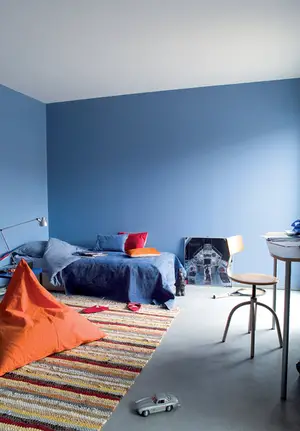What is the best paint to use on walls? Painting is the first thing you do to a new house or when you want to renew the appearance of the walls. It is easy and makes everything look cleaner, fresher, and new. To choose white wall paint, you should consider two things. They are identifying whether you’re going to paint new or good-looking walls, or whether you’re going to paint walls with specific problems to solve.
To choose the right paint, first of all start with the environment you want to paint, whether it is a house or a public place that will require certification. Evaluate the state of the walls, whether they are in good condition or have problems, and the material they are made of.
If the walls are in good condition, you can use any type of wall painting to renew the look of the room, remove dirt, and cover old colors. Choose the type of paint that best suits the environment you want to paint. This can be your bathroom, kitchen, bedrooms, or living rooms. Read on to find the best types of paints for walls!
What Is the Best Paint to Use on Walls
Anti-mold paint: contains biocide and antifouling additives, and prevents the formation of mold caused by excessive moisture.
The anti-condensation paint: insulates and protects against temperature changes. It is suitable for all perimeter walls, and for rooms with a high presence of steam, such as bathrooms and kitchens. In addition, it prevents the formation of mold caused by temperature change.
Paints for difficult stains: covers tough stains such as coffee, markers, graphite, smoke, or moisture.
Paint to cover very intense colors: it has a very high degree of coverage. Moreover, it can remove very intense, dark and difficult to cover colors, such as red and black.
Paint for chalking surfaces: 2 in 1 paint is a unique solution that includes paint and primer preparation. It helps to consolidate old substrates that tend to flake.
Characteristics and Types of Interior Painting
Interior wall paint consists of water, resins, pigments, and additives (anti-mold, fungicides). For this reason, it is also known as water paint.
What Is the Best Paint to Use on Walls – The Main Types
Tempera
Tempera is an economical solution because it is poor in resins, breathable, but not very opaque. It is suitable for painting environments of occasional use or service, such as garages and cellars.
With time it “dusts”, for example, by touching the wall you can get dirty with white. In case of a future painting, it is always best to use a fixative.
Breathable Paint
It allows the walls to permeate vapors and humidity, so it is ideal for very humid and subject to condensation areas such as bathrooms and kitchens.
Washable and Super-Washable Paint
Rich in resins and pigments such as titanium dioxide, it guarantees excellent coverage and resistance to dirt and rubbing. It is suitable for all rooms in the house, in particular the living room, bedrooms, and places of passage.
Furthermore, you can use it for bathrooms and kitchens, if they are not excessively damp. That is because it allows you to remove dirt with a freshly dampened cloth, without removing paint.
Wall Enamel
It has excellent coverage and once dry, forms a film with a glossy, satin, or matt appearance. In addition, it is very washable, even with detergents. For this reason, it is suitable in all environments where cleaning is necessary, such as kindergartens, medical surgeries, and waiting rooms.
Evaluate The Coverage:
A paint with a high degree of coverage allows you to better cover the surface, and obtain a good result with fewer coats of product. For example, a one-handed paint guarantees an excellent result with just one application of product. In case of difficult stains, choose a specific stain-resistant paint.
Material of the Substrate to Paint:
Masonry, wood, plasterboard already painted: Choose wall paints and enamels.
New, never treated plasterboard: choose a paint suitable for plasterboard.
Cement: requires a specific paint, called anti carbonation paint.
Calculate How Much Product You Need
On each can of paint is reported its yield in m². This is the surface that you can paint with that can of paint by applying a single coat of product.
Calculate the surface area in m² of the wall, multiplying width by height and subtracting the size of doors and windows.
Consider that to obtain a good result you will have to apply two coats of paint, so you will have to multiply the surface to be painted by two.
What Is the Best Paint to Use on Walls – Tips for Home Painting
Choose a day when it’s not raining and with warm temperatures, but not too sultry, so that the paint can dry quickly. Before you start painting your home, protect your doors, windows, and floor with plastic sheeting and masking tape. To paint the walls properly, make sure you have everything you need with you.
In the case of old or damaged surface, before painting it is important to treat the wall in order to restore it and prevent its deterioration in the future. Good preparation of the surface is crucial for a good result and will make the paint last longer.
Moreover, remove any parts of paint damaged by moisture with the help of a brush, scraper, and spatula.
Then, fill the cracks or restore any missing parts with an interior filler or plaster. If the cracks are larger, before filling them, you must widen them with a chisel, peel off the parts of old paint that are peeling off, and carefully sand the entire surface.
Furthermore, apply a specific primer for interior use to improve the adhesion of the paint. For walls with mold and humidity problems, choose an anti-mold fixative primer.
If there are stains of mold, fungus and algae, you must first remove them by washing the surface with specific cleaning agents and a brush.

